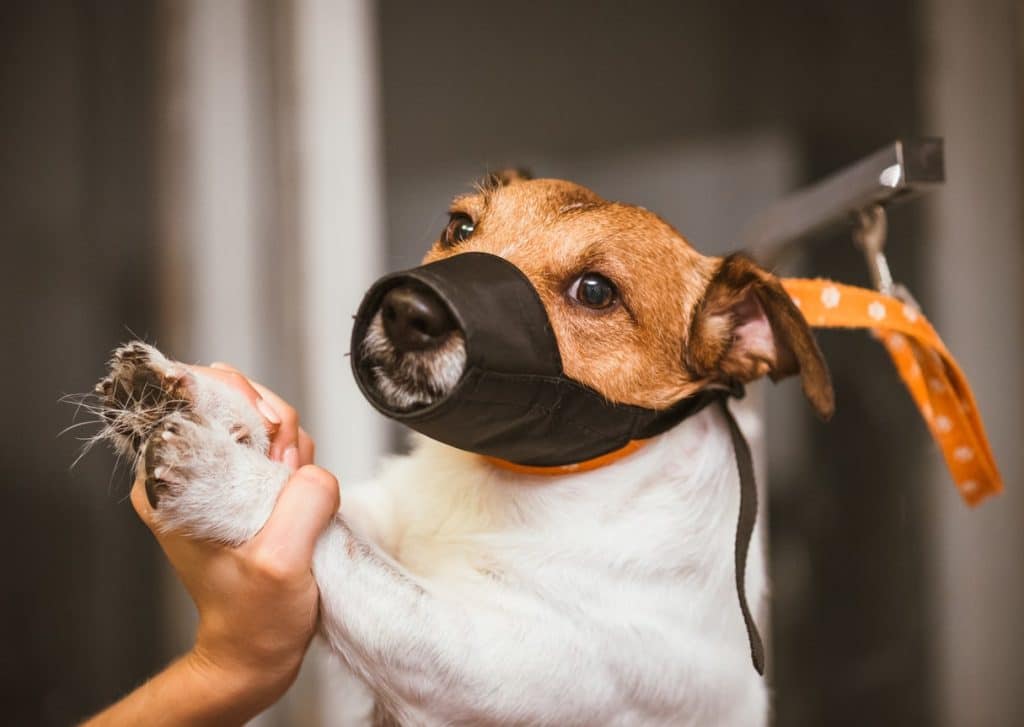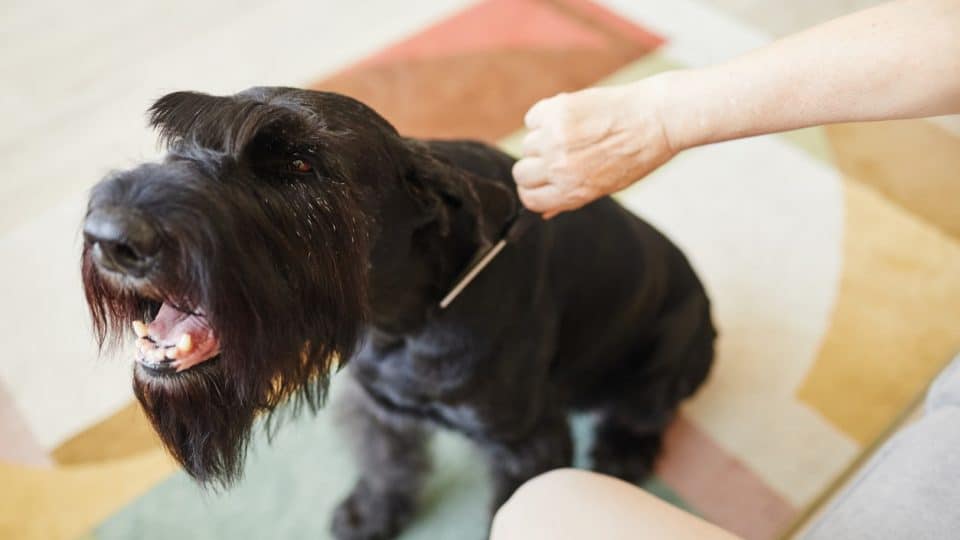- Not a substitute for professional veterinary help.
If your dog had a bad experience or isn’t used to being groomed, they might get scared or aggressive when they see brushes and nail clippers. Signs of aggression include:
Grooming an aggressive dog can be difficult, but it’s very important for their health. With the right tools and a positive attitude, you can make grooming easier and less stressful for both of you. You might want to work with a professional groomer or trainer who can help you and your dog feel more comfortable during grooming.
If you want expert tips on how to groom a dog who gets angry at home, keep reading for everything you need to know!
Why Dogs Get Aggressive During Grooming
Dogs use aggression to communicate, says Rhiannon van Lidth de Jeude Roemer (KPA-CTP), a trainer at Raintown Dog Training. This means that when your dog growls, shows their teeth, or acts out during grooming sessions, they’re trying to tell you they feel uncomfortable.
As pet parents, it’s our job to understand why they feel this way. Here are some common reasons why dogs might act aggressive during grooming:
How to Get Your Aggressive Dog Ready for Grooming
Before you groom your dog, here are some tips to help you get ready:
Start when they’re young
The best time to start grooming is when your dog is young, says Rachel Rollins (KPA-CTP), a trainer and founder of Rollins Dog Training.
She recommends gently touching your dog’s paws, toes, and tail, looking in their ears, and rubbing their teeth with a finger or toothbrush.
Pick a quiet spot
Choose a quiet room where your dog feels comfortable. This will help them stay calm and not get distracted.
Use the right grooming tools
To safely groom your dog at home, use high-quality brushes, says dog groomer Mandy Yovanovic.
The kind of brush you need depends on your dog’s fur, so ask your groomer or vet if you’re not sure.
Have safety tools on hand
To keep dogs safe, groomers often use tools like grooming tables, loops, and muzzles. If you want to use these at home, ask your groomer how to use them properly. “Basket muzzles are the most comfortable and safe type,” says Rollins—but these must be introduced slowly.
You can also use calming sprays during grooming; in some cases, vets might prescribe sedatives. While calming sprays are easy to buy, sedatives need a vet’s prescription.
How to Safely Groom Your Aggressive Dog in 7 Steps
If you need to groom your aggressive dog at home, here’s how to do it safely.
1. Start slow
“It’s a good idea to get your dog used to being brushed, trimmed, and bathed long before you need to get any grooming done,” van Lidth de Jeude Roemer says.
She suggests starting with short sessions. First, show your dog the grooming tools. Then, gently touch them with the tools. Work on one part of their body at a time until they’re comfortable.
2. Use treats
While getting your dog used to grooming tools, use plenty of treats and positive reinforcement. Van Lidth de Jeude Roemer recommends giving your dog a treat after each movement (a stroke of the brush or a snip of the scissors, for example) to create a positive experience for your dog.
It’s also important to choose a high-value treat your dog loves. “This isn’t the time for milk bones—bring on the freeze-dried chicken!” says Allie Bender (CPDT-KA), a certified dog behaviorist, trainer, and founder of Pet Harmony.
3. Watch for stress signals
If your dog looks stressed, like showing side-eye, staying stiff, or flattening their ears, take it easy.
“The goal is that your pup not only tolerates being groomed—but loves it!” she adds.
4. Stay calm
“Whatever craziness ensues during your grooming session, stay calm,” says Yovanovic.
She says to Talk in a calm tone and frequently tell your dog that everything is going to be okay.
5. Take lots of breaks
Bender says the worst thing you can do is rush your dog (especially if you’re almost done).
“Many of our clients clip a nail or two every day or so, and that’s a great schedule for them and their dog,” she adds.
6. Get help from a friend
If your dog tries to wiggle or run around, Yovanovic says it can be hard to groom them.
Having a friend gently distract your dog with treats or a lick mat can help make grooming quicker and easier.
7. Train your dog to wear a muzzle
“A well-fitted basket muzzle is a good safety net when grooming a dog who is at risk of biting,” van Lidth de Jeude Roemer explains. Start slowly and use lots of treats until your dog is comfortable with the muzzle.
Van Lidth de Jeude Roemer adds that a muzzle is just for safety, but it’s still important to help your dog feel good about grooming. If you’re nervous about grooming, contact a professional for help.

iStock/alexei_tm
When to Hire a Professional Groomer
If you don’t feel comfortable grooming your aggressive dog at home, you can work with a professional groomer. They have the skills to groom your dog safely.
“Choosing the right groomer for your dog is important because they have unique needs and personalities, so what’s comfortable for one dog may not be for another,” says Kim Kier, a Fear-Free certified pet aesthetician and founder of Little Barks Grooming & Boutique.
Kier also mentions that anyone can start grooming without training or experience. So, it’s important to do your homework. Ask friends for recommendations, check the groomer’s credentials, and read reviews from other clients.
Tips for Easing Your Dog’s Grooming-Related Aggression
Kier explains that a positive grooming experience can help your dog feel safe and even enjoy it. Reward calm behavior with treats and praise, which, over time, can reduce fear, anxiety, and stress—common causes of aggression.
Desensitizing your dog to grooming tools can also help. Here’s how Yovanovic suggests you start:
- Start with the tools: Place a grooming tool like nail clippers or a Dremel in the room with you and your dog. Let your dog see the tool, and then give them a treat they really love. Do this for three or four days.
- Bring them closer: Once your dog is used to seeing the tool, move it closer to them—about five or six feet away. Let them see it, then give them a treat. Repeat this every day for three or four days.
- Move it even closer: Put the tool about one foot away from your dog on a couch or table. Let them see it, then give them a treat. Do this every day for three or four days.
- Let your dog sniff it: Hold the tool and let your dog sniff it. Gently touch their leg, side, or paw with it. Do this every day for three or four days.
- Practice holding their paw: If you’re using nail clippers or a Dremel, see if you can hold your dog’s paw while holding the tool. Don’t clip their nails yet, but reward them with a treat and praise. If you’re using a Dremel, turn it on near their paw and treat them. Do this for three or four days. If your dog doesn’t let you do this yet, go back to step 4.
- Try clipping or filing one nail: Once your dog is comfortable, try clipping or using the Dremel on one nail. Be careful not to cut too far. If your dog stays calm, give them a treat and praise. If they get upset, stop and go back to step 5.
Grooming for Aggressive Dogs FAQs
What are some additional signs of grooming aggression?
Kier says some common signs that your dog is feeling aggressive during grooming are:
- Panting
- Licking
- Pacing
- Tail down
- Stiff body
- Hiding
- Wide eyes and ears back
Can I sedate my dog during grooming?
Sedation is possible but must be done by a vet. It’s better to try other ways to help your dog feel comfortable, like desensitization.
How do I immobilize my dog during grooming?
Grooming tables, harnesses, and restraints around your dog’s head and neck can gently hold your dog in place, but these are usually used by trained groomers who know how to use them safely.
How do I calm my dog before grooming?
A long walk or playtime at the dog park can help your dog burn off extra energy. Calming sprays may also help some dogs relax.
Can regular grooming help my dog’s aggression?
Yes, regular grooming can help your dog get used to the process. By keeping sessions short and positive, your dog can start to feel more comfortable over time, which can help reduce aggression.



